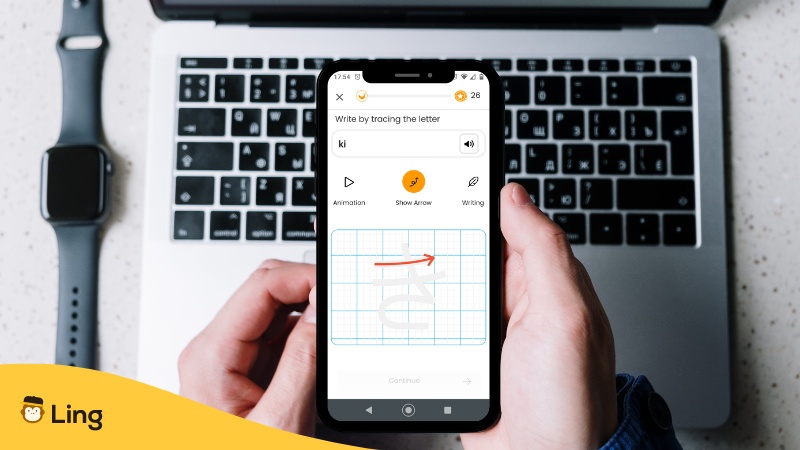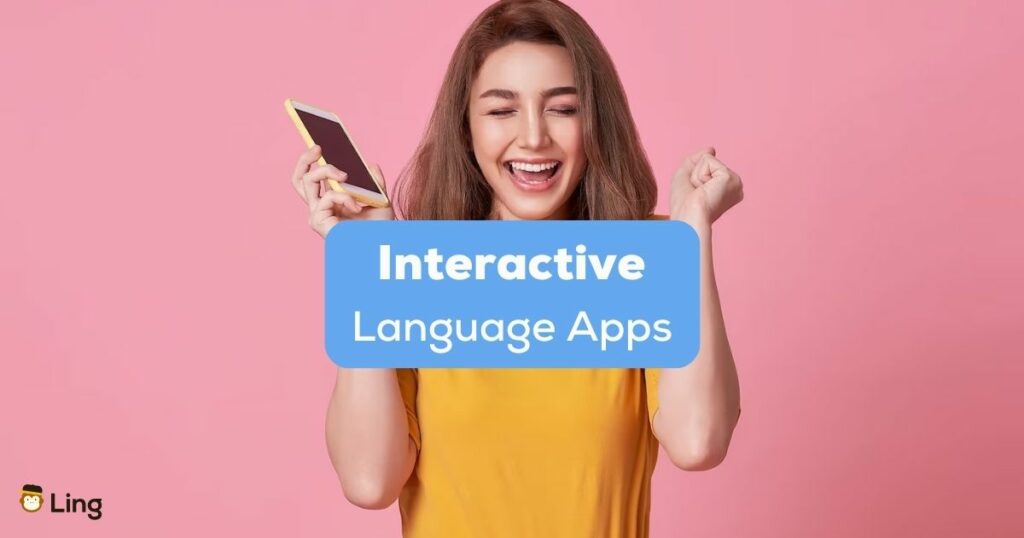So, you’re here because you want to dive deep into a new language, right? You’re not just looking to memorize a few phrases. You want a real, interactive experience. Good news: you’re in the right place.
This article is your roadmap to the six top interactive language apps that make learning fun and effective. Interactive learning is proven to make education more engaging and effective, and these apps go beyond the basics, offering a full-on, engaging learning journey. Wondering how our Ling app measures up to these stellar picks? Stay tuned to find out.
| App | Best For | Starting Price |
| Ling app | Interactive Mini-Games | $14.99/month |
| Babbel | Interactive Conversations | $9.60/month |
| Rosetta Stone | Interactive Immersion | $15.99/month |
| Pimsleur | Interactive Audio Lessons | $19.99/month |
| italki | One-on-One Interactive Sessions | $5 to $40 per hour |
| Duolingo | Gamified Interactive Lessons | $9.99/month |
The Ling App: Best For Interactive Mini-Games
Let’s start with the best language-learning app: the Ling app. And let me tell you, this one’s a gem. Mini-games? Check. Vocabulary drills? Absolutely.
But it’s the chatbot that steals the show. This clever feature doesn’t just respond. It engages you in a conversation that feels as real as chatting with a native speaker.
The secret sauce here is spaced repetition. This cognitive technique ensures that what you learn sticks around for the long haul.
I’ve tried my fair share of language apps, and the Ling app’s targeted approach is a breath of fresh air. If you’re looking for an app that’s as interactive as it is effective, you should definitely check out the Ling app.
Transform Your Language Skills in a Week – Get the Ling App Today!
The Ling App’s Standout Features
- Chatbot Conversations for Real-World Practice: The Ling app offers a unique chatbot feature that simulates real-world conversations. This interactive element allows you to practice dialogues in a safe, low-pressure environment, making transferring your skills to real-world interactions easier.
- Retention-Centric Learning Games: The Ling app takes retention seriously. It employs a game-like format for its exercises. This makes the learning process interactive and effective in helping you remember what you’ve learned.
- Progress Tracker with Leaderboard: The Ling app lets you keep tabs on your learning journey. It has a built-in progress tracker and a streak feature. You can also earn points and climb the leaderboard, adding a competitive twist to your language learning.
What Are Users Saying About The Ling App?
- Rating: 4.7 stars with 11.6K reviews on Google Play.
- Positive Feedback: Users love the Ling app’s unique language offerings. One reviewer said, “This is the only app I found that offers every language I am studying.” The user-friendly interface also got a thumbs-up.
- Room for Improvement: Users are so engaged with the Ling app that they ask for even more detailed explanations in future updates. One user said, “I love the app and can’t wait to see more in-depth grammar explanations in upcoming updates.”
How Much Does The Ling App Cost?
- Free version with beginner lessons and an introductory chatbot.
- $14.99 per month for the Premium Version, with access to all the lessons in 60+ languages and all features unlocked.
- $79.99 per year for the same features as the monthly subscription.
- $149.99 for lifetime access (one-time purchase).
Devices: Android, iOS, web.
Babbel: Best For Interactive Conversations
Babbel’s up next, and it’s a powerhouse for conversation. I’ve personally used it, and the real-life dialogues are a game-changer.
The app’s speech recognition tech gives you instant feedback on your pronunciation. No second-guessing if you’re saying it right.
And Babbel doesn’t stop at conversation. Each lesson is a mini culture course, offering grammar tips and cultural understandings that most interactive language apps just gloss over.
Babbel’s Standout Features
- Quick, Interactive Lessons: Babbel knows you’re busy. That’s why it offers lessons designed to be completed in 10–15 minutes. These aren’t dull lessons. They’re interactive and designed to keep you engaged.
- Contextual Language Learning: Babbel goes beyond basic vocabulary. It offers lessons tailored for real-world scenarios like travel and work, helping you apply your language skills where they matter most.
- Advanced Speech Recognition: Babbel isn’t just about learning to read and write. It wants you to speak correctly. It employs advanced speech recognition technology to fine-tune your pronunciation.
What Are Users Saying About Babbel?
- Rating: 4.6 stars with 957K reviews on Google Play.
- Positive Feedback: Babbel’s depth and structure are winning hearts. “Babbel is more interesting, challenging, and useful than those two combined. It has more variety, content, and depth,” a user noted.
- Room for Improvement: However, the speech recognition feature has room for improvement. “Many times when speaking, the app does not recognize the correct pronunciation,” a user mentioned.
How Much Does Babbel Cost?
- Free version with access to the first lesson in every course.
- 1 month (one language): $9.60
- 3 months (one language): $28.80
- 12 months (one language): $115.20
- Lifetime (all languages): $319
Devices: Android, iOS, web.

Rosetta Stone: Best For Interactive Immersion
Now, let’s talk about the granddaddy of the best language-learning apps: Rosetta Stone. This app plunges you into the deep end, immersing you in your target language.
But it’s not a sink-or-swim scenario. Features like TruAccent speech recognition offer a lifeline, making the experience interactive.
What sticks to me is their commitment to total immersion. You don’t just learn phrases, it feels like you’re living the language.
Unlike Pimsleur, which leans heavily on audio, Rosetta Stone offers a more tactile, interactive experience. If you’re up for a challenge, you’ll find it here.
Rosetta Stone’s Standout Features
- TruAccent Technology: Rosetta Stone employs its patented TruAccent speech recognition to refine your pronunciation. This ensures you’re not just understanding the foreign language but speaking it like a native.
- Dynamic Immersion Method: Rosetta Stone uses a unique immersive method. It teaches you new words and phrases within the context of complete sentences, helping you grasp the language’s structure and syntax.
- Real-Time Tutoring: The app offers live tutoring sessions with native speakers. This feature lets you practice speaking and receive immediate feedback, making your learning experience interactive.
What Are Users Saying About Rosetta Stone?
- Rating: 4.7 stars with 375K reviews on Google Play.
- Positive Feedback: The immersive approach is a big hit. “This app is amazing for learning languages through immersion. It’s like being in the country without leaving your home,” a user raved.
- Room for Improvement: The price point, though, is a bit of a hiccup. “The app is great, but the subscription cost is a bit high for me,” a user stated.
How Much Does Rosetta Stone Cost?
- 3 months for $47.97 ($15.99 per month).
- One year for $126 ($10.50 per month).
- Lifetime access for $199.
Devices: iOS, Android, and Web.
Pimsleur: Best For Interactive Audio Lessons
Switching gears, let’s delve into Pimsleur. This language app is an auditory feast. Each lesson is a simulated conversation, and you’re not just a passive listener. The app pauses, you speak, and then it continues.
The standout feature? It’s the focus on auditory learning. Yes, you’re parroting back phrases with Pimsleur, but you’re actively participating in a dialogue here.
And like other language apps, Pimsleur also offers unlimited access to its course materials. If you’re an auditory learner, this is your haven.
Pimsleur’s Standout Features
- Audio-First Approach: Pimsleur sets itself apart with its audio-centric learning. You’re not just staring at a screen. You’re listening and speaking. This method is perfect for absorbing the language naturally, almost like you’re in a conversation.
- Cultural Nuances and Context: Pimsleur doesn’t just teach you words; it teaches you culture. The app includes cultural insights that help you understand the “why” behind the words, making your learning more holistic and nuanced.
- Quick Match Quiz for Skill Assessment: Pimsleur offers a unique Quick Match Quiz feature. This isn’t your typical quiz. It’s designed to interactively test your language comprehension and vocabulary, helping you identify areas where you might need more practice.
What Are Users Saying About Pimsleur?
- Rating: 4.3 stars with 10.5K reviews on Google Play.
- Positive Feedback: The audio lessons are a standout feature. “The audio lessons are fantastic for learning on the go. I can practice while driving or doing chores,” a user said.
- Room for Improvement: Some users wish for more written exercises. “I wish there were more written exercises to complement the audio lessons,” a user suggested.
How Much Does Pimsleur Cost?
- Premium subscription (One Language): $19.99/month
- All Access subscription (All Languages): $20.99/month
- Courses can also be bought separately for around $119.95 per level, depending on the language.
Devices: Android, iOS, audio downloads.

italki: Best For One-On-One Interactive Sessions
Meet italki, the platform that connects you directly with language teachers worldwide. One-on-one sessions make this as interactive as it gets. The platform allows you to choose your teacher, tailoring the experience to your learning style and objectives.
What sets italki apart is its flexibility. You can choose your lessons to focus on whatever you want, whether that’s mastering conversational skills or diving into the intricacies of grammar.
Unlike the Ling app and Duolingo, which offer more structured experiences, italki lets you steer your learning journey.
italki’s Standout Features
- Language Exchange Community: italki is a community. The built-in language exchange feature lets you practice with native speakers, adding a social and interactive layer to your learning journey.
- Group Classes: italki doesn’t just offer one-on-one lessons; they also have group classes that can help make the experience more dynamic.
- Flexible Pricing Options: italki understands that budget matters. The app offers a wide range of pricing options, from as low as $5 to as high as $40 per hour, allowing you to find a tutor that fits your financial situation.
What Are Users Saying About italki?
- Rating: 4.8 stars with 13K reviews on Google Play.
- Positive Feedback: Users love the one-on-one lessons. “The personalized lessons are a game-changer. I feel like I’m learning faster than ever,” a user exclaimed.
- Room for Improvement: Yet, some language learners desire a more structured curriculum. “I love the one-on-one sessions, but I wish there were a more structured path to follow,” a user noted.
How Much Does italki Cost?
- Lessons cost from $5.00 to $40.00 per hour, depending on the tutor.
Devices: Android, iOS, and Web.
Duolingo: Best For Gamified Interactive Lessons
Finally, we’ve got Duolingo. This app is more than just a collection of mini-games. It’s a community. You can join clubs, compete on leaderboards, and even attend virtual events.
But don’t let the fun fool you. Duolingo’s lessons are designed to be compelling, engaging, and, yes, educational.
The app offers podcasts and stories to deepen your understanding of the language. It’s an app that provides a comprehensive, interactive, and community-driven experience.
Duolingo’s Standout Features
- Adaptive Learning Algorithms: Duolingo isn’t static; it adapts to you. The app uses algorithms to identify your strengths and weaknesses, tailoring future lessons to focus on areas where you need improvement.
- Competitive Element: Duolingo’s leaderboards, leagues, and tournaments can help with motivation for those who are more on the competitive side.
- Interactive Stories for Contextual Learning: Duolingo goes beyond vocabulary lists. The app features interactive stories that require active participation, helping you understand the context and usage of words and phrases in a fun, engaging way.
What Are Users Saying About Duolingo?
- Rating: 4.7 stars with 17.6M reviews on Google Play.
- Positive Feedback: The gamified approach is a hit. “This app makes learning a new language fun and addictive. I can’t put it down!” a user gushed.
- Room for Improvement: But the ads can be a buzzkill. “The ads can be a bit annoying and interrupt the flow of learning,” a user mentioned.
How Much Does Duolingo Cost?
- Free version with access to most of its features.
- The Premium version, Duolingo Plus, costs $9.99 per month. It has no ads and extra features.
- There’s also a yearly subscription for $83.99.
Devices: Android, iOS, Web.

Why Use Interactive Language Apps?
Turning language learning into an interactive process can have many benefits.
- Motivation: A great advantage these apps have is their engaging way of teaching complicated subjects such as grammar and sentence structure. This can help users stay motivated throughout the process and make them less likely to quit. Why give up when you’re having fun, right?
- Active Learning: Incorporating interactive activities into language learning, such as games and exercises, promotes a more active way of learning. This can be very helpful for retention and can benefit users who have trouble memorizing concepts.
- Cost-Effectiveness: Let’s be real. Traditional language lessons can be very expensive. In contrast, many language-learning apps have more accessible prices. Learners who’re on a budget can greatly benefit from this, as the lower price tag doesn’t mean they’re any less effective, especially at the beginner stages.
Do Interactive Language Apps Make You Fluent?
Absolutely, interactive learning is your ticket to fluency. Why? Because it keeps you engaged, helps you remember better, and as we said, it’s just more fun.
But fluency isn’t an overnight thing. It’s a long-term commitment. You’ve got to immerse yourself in the native language, understand its nuances, and even get a feel for its culture.
And speaking of immersion and culture, let’s circle back to the Ling app, our very own offering in this space. If you’ve wondered how it stacks up, here’s your answer.
We’ve got retention-focused lessons, a broad vocabulary range, and a chatbot that’s smart enough to help you practice real conversations. It’s this attention to detail that sets the Ling app apart as your ultimate language-learning companion.
Plus, we offer daily language articles that dig deep into grammar intricacies and cultural tidbits you won’t find in other interactive language apps.
So, are you in? Download the Ling app today from Google Play and the App Store. Believe me, this is where your language journey takes a turn for the best.



































































